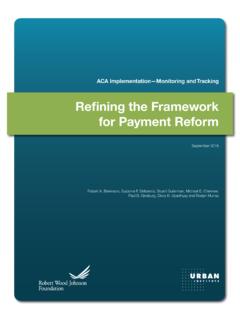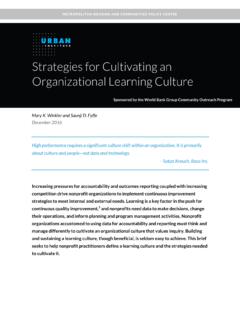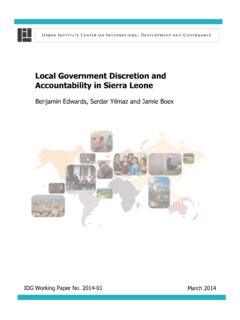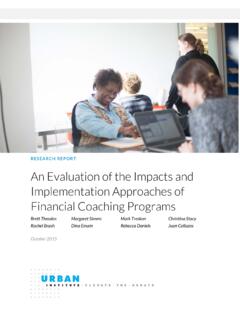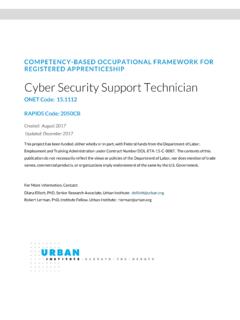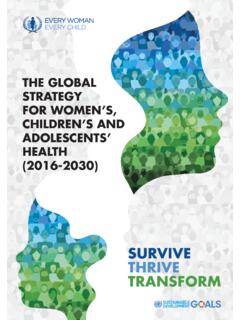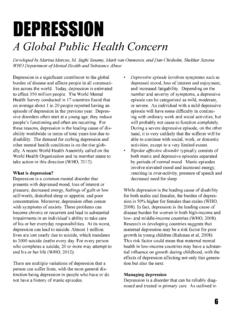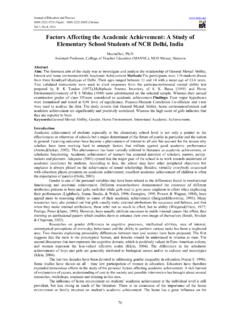Transcription of The Negative Effects of Instability on Child Development ...
1 The Negative Effects of Instability on Child Development : A Research Synthesis Heather Sandstrom Sandra Huerta September 2013 Low-Income Working Families Discussion Paper 3 Copyright September 2013. The Urban Institute. All rights reserved. Except for short quotes, no part of this report may be reproduced in any form or used in any form by any means, electronic or mechanical, including photocopying, recording, or by information storage or retrieval system, without written permission from the Urban Institute.
2 This report is part of the Urban Institute s Low-Income Working Families project, a multiyear effort that focuses on the private- and public-sector contexts for families success or failure. Both contexts offer opportunities for better helping families meet their needs. The Low-Income Working Families project is currently supported by the Annie E. Casey Foundation. The authors thank Gina Adams and Lisa Dubay for their tremendous support in creating this paper and for their ongoing input in the writing process. They also thank Margaret Simms and Julia Isaacs for their extensive review and comments which shaped the final draft.
3 The nonpartisan Urban Institute publishes studies, reports, and books on timely topics worthy of public consideration. The views expressed are those of the authors and should not be attributed to the Urban Institute, its trustees, or its funders. Contents Executive Summary 4 What Do We Know about Instability ? 4 What Are the Effects of Various Types of Instability on Child Development ? 5 Implications for Policy and Practice 7 The Negative Effects of Instability on Child Development 9 What Do We Mean by Instability ? 10 Why Does Instability Matter?
4 12 Theoretical Framework 13 Economic Instability 15 Employment Instability 21 Family Instability 24 Residential Instability 28 Instability in Out-of-Home Contexts: School and Child Care 32 The Role of Parenting and Parental Mental Health among Unstable Families 38 Conclusions 40 Notes 46 References 47 About the Authors 57 4 Executive Summary children s early experiences shape who they are and affect lifelong health and learning. To develop to their full potential, children need safe and stable housing, adequate and nutritious food, access to medical care, secure relationships with adult caregivers, nurturing and responsive parenting, and high-quality learning opportunities at home, in Child care settings, and in school.
5 Research shows that a large number of children face Instability in their lives. Researchers from various fields of study developmental psychology, sociology, economics, public policy, demography, and family studies have independently explored different domains of Instability in the supportive structures that predict children s outcomes. However, little effort has been made to look across research disciplines and study contexts to synthesize our knowledge base and draw connections among the various domains of Instability . In this synthesis paper, we build this knowledge base by exploring the extant literature on the Effects of Instability on children s developmental outcomes and academic achievement.
6 In our discussion, we review and synthesize research evidence on five identified domains of Instability that have been well established in the literature: family income, parental employment, family structure, housing, and the out-of-home contexts of school and Child care. In our review of the evidence, we also discuss some of the key pathways through which Instability may affect Development . Specifically, research points to the underlying role of parenting, parental mental health, and the home environment in providing the stability and support young children need for positive Development .
7 We conclude with recommendations for policy and practice to alleviate the impact of Instability . This examination will serve as a resource to policymakers and practitioners concerned with programs and services for children and families, and build a foundation for future research in this area. What Do We Know about Instability ? The term Instability is often used in social science research to reflect change or discontinuity in one s experience; however, operational definitions of Instability vary by field and are often determined by the data and measures available for research.
8 Whereas some literature looks at the Effects of change measured broadly, change itself can have both positive and Negative implications depending on the context, including whether the change is voluntary, planned in advance, and moving the individual 5 or family to better circumstances. For our purposes, Instability is best conceptualized as the experience of change in individual or family circumstances where the change is abrupt, involuntary, and/or in a Negative direction, and thus is more likely to have adverse implications for Child Development .
9 Changes do not occur in isolation but rather a disruption in one domain ( , parent employment) often triggers a disruption in another domain ( , Child care) in a domino effect fashion. In some cases, the causality of Instability is not one-dimensional but a result of a complicated series of events that compound over time. This domino effect may be most evident among low-income or lower middle-class families who lack savings and assets that they can tap into during temporary periods of transition (McKernan, Ratcliffe, and Vinopal 2009; Mills and Amick 2010).
10 children thrive in stable and nurturing environments where they have a routine and know what to expect. Although some change in children s lives is normal and anticipated, sudden and dramatic disruptions can be extremely stressful and affect children s feeling of security. Within the context of supportive relationships with adults who act as a buffer against any Negative Effects of Instability , children learn how to cope with adversity, adapt to their surroundings, and regulate their emotions (National Scientific Council on the Developing Child 2007).
